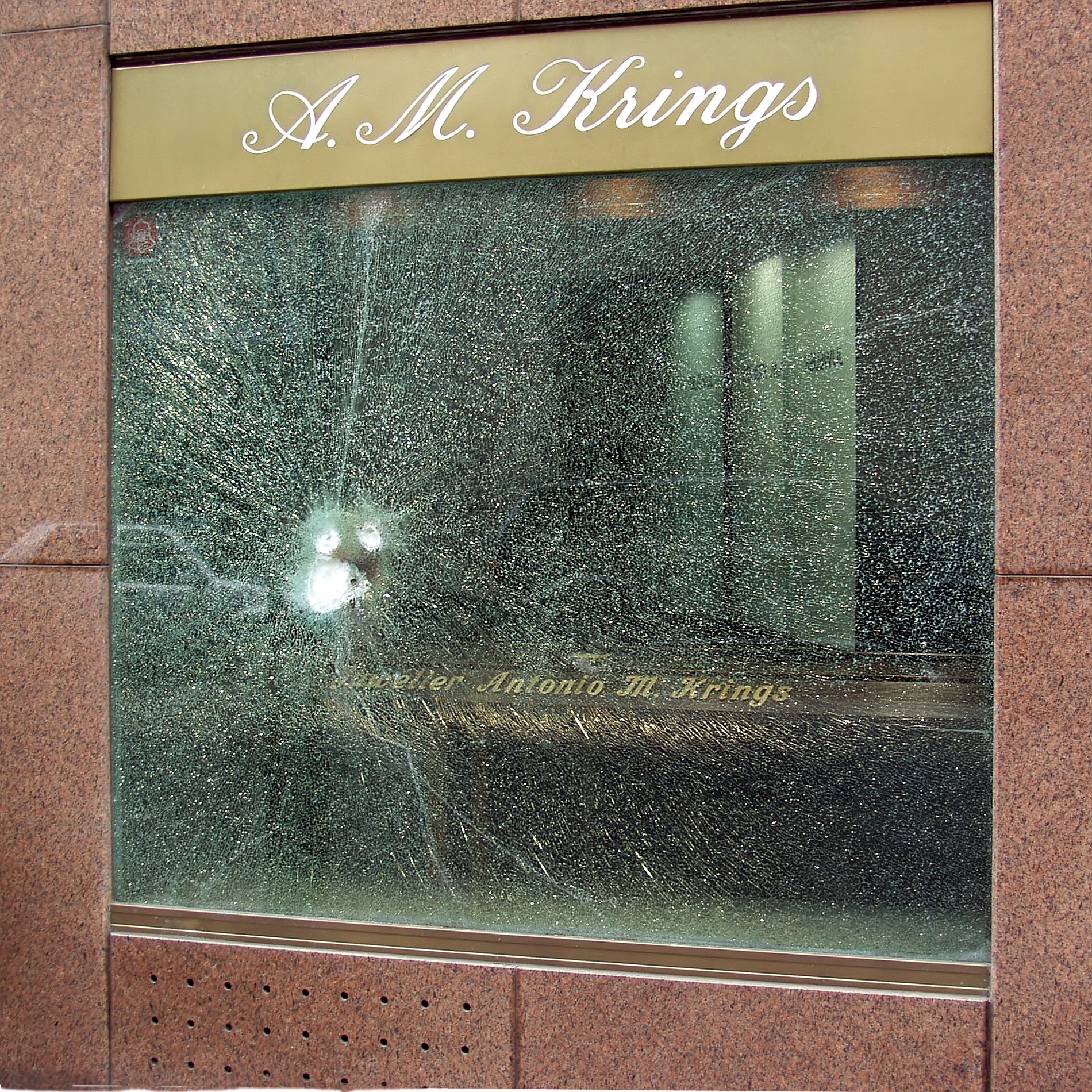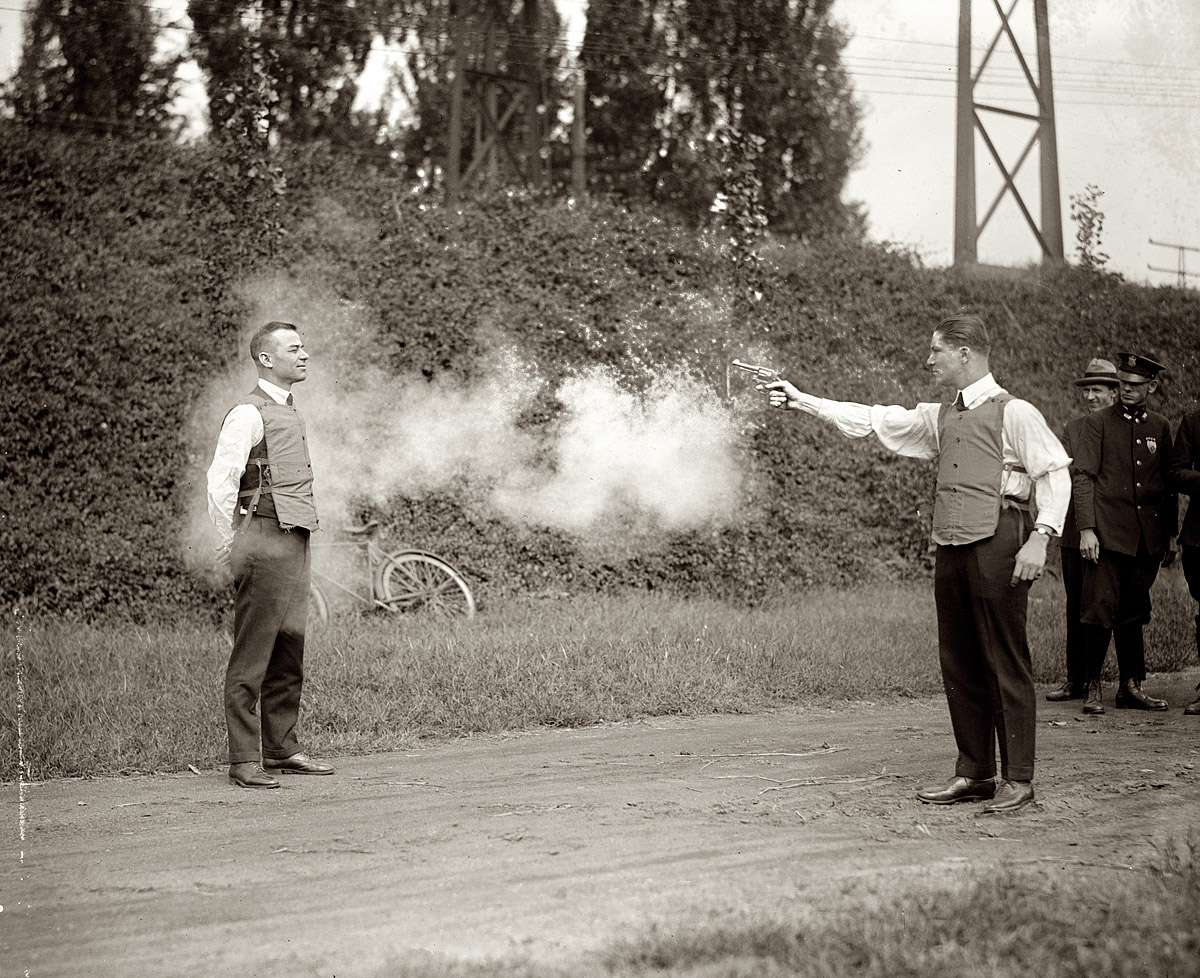|
Bulletproof Glass
Bulletproof glass, ballistic glass, transparent armor, or bullet-resistant glass is a strong and optically transparent material that is particularly resistant to penetration by projectiles. Like any other material, it is not completely impenetrable. It is usually made from a combination of two or more types of glass, one hard and one soft. The softer layer makes the glass more elastic, so that it can flex instead of shatter. The index of refraction for all of the glasses used in the bulletproof layers must be almost the same to keep the glass transparent and allow a clear, undistorted view through the glass. Bulletproof glass varies in thickness from . Bulletproof glass is used in windows of buildings that require such security, such as jewelry stores and embassies, and of military and private vehicles. Construction Bullet-resistant glass is constructed using layers of laminated glass. The more layers there are, the more protection the glass offers. When a weight reduction is ... [...More Info...] [...Related Items...] OR: [Wikipedia] [Google] [Baidu] |
Bulletproof Glass Window After A Burglary Attempt
Bulletproofing is the process of making an object capable of stopping a bullet or similar high velocity projectiles (e.g. shrapnel). The term bullet resistance is often preferred because few, if any, practical materials provide complete protection against all types of bullets, or multiple hits in the same location, or simply sufficient kinetic (movement) energy to overcome it. Origins In 1887, George E. Goodfellow, of Tombstone, Arizona, documented three cases where bullets had failed to penetrate silk articles of clothing. He described the shooting death of Charlie Storms by gambler Luke Short. Although Storms was shot in the heart, "not a drop of blood" exited the wound. Goodfellow found that, though the bullet did indeed kill Storms, it failed to pass through a silk handkerchief. The handkerchief essentially caught the bullet, but not sufficiently to stop the bullet penetrating Storms. Another example was the killing of Billy Grounds by Assistant City Marshal Billy Breake ... [...More Info...] [...Related Items...] OR: [Wikipedia] [Google] [Baidu] |
50 BMG
The .50 Browning Machine Gun (.50 BMG, 12.7×99mm NATO and designated as the 50 Browning by the C.I.P.) is a caliber cartridge developed for the M2 Browning heavy machine gun in the late 1910s, entering official service in 1921. Under STANAG 4383, it is a standard service cartridge for NATO forces as well as many non-NATO countries. The cartridge itself has been made in many variants: multiple generations of regular ball, tracer, armor-piercing (AP), incendiary, and saboted sub-caliber rounds. The rounds intended for machine guns are made into a continuous belt using metallic links. The .50 BMG cartridge is also used in anti-materiel rifles. A wide variety of ammunition is available, and the availability of match grade ammunition has increased the usefulness of .50 caliber rifles by allowing more accurate fire than lower quality rounds. History In response to the need for new anti-aircraft weaponry during World War I, John Browning developed the .50 BMG. He wanted the ... [...More Info...] [...Related Items...] OR: [Wikipedia] [Google] [Baidu] |
Transparent Armor Gun Shield
Built by BAE Systems, the Transparent Armor Gun shield, or TAGS, is a visually transparent protective gun shield for operators of vehicle-mounted machine guns. It borrows on the experience of the Israeli Defense Force in using such armor on a variety of vehicles. The shield is intended to provide protection for its user while maintaining visibility. It can be mounted on several models of armoured fighting vehicles (AFVs), including the M113, M1 Abrams and Stryker, as well as on the HMMWV The High Mobility Multipurpose Wheeled Vehicle (HMMWV; colloquial: Humvee) is a family of light, four-wheel drive, military trucks and utility vehicles produced by AM General. It has largely supplanted the roles previously performed by the ori .... References External links BAE Systems press release Vehicle armour {{US-mil-stub Armoured fighting vehicle equipment ... [...More Info...] [...Related Items...] OR: [Wikipedia] [Google] [Baidu] |
Ceramic
A ceramic is any of the various hard, brittle, heat-resistant and corrosion-resistant materials made by shaping and then firing an inorganic, nonmetallic material, such as clay, at a high temperature. Common examples are earthenware, porcelain, and brick. The earliest ceramics made by humans were pottery objects (''pots,'' ''vessels or vases'') or figurines made from clay, either by itself or mixed with other materials like silica, hardened and sintered in fire. Later, ceramics were glazed and fired to create smooth, colored surfaces, decreasing porosity through the use of glassy, amorphous ceramic coatings on top of the crystalline ceramic substrates. Ceramics now include domestic, industrial and building products, as well as a wide range of materials developed for use in advanced ceramic engineering, such as in semiconductors. The word "'' ceramic''" comes from the Greek word (), "of pottery" or "for pottery", from (), "potter's clay, tile, pottery". The earliest kno ... [...More Info...] [...Related Items...] OR: [Wikipedia] [Google] [Baidu] |
50 Caliber
This is a list of firearm cartridges which have bullets in the to caliber range. *''Length'' refers to the cartridge case length. *''OAL'' refers to the overall length of the cartridge. *''Bullet'' refers to the diameter of the bullet. Some measurements are in millimetres, while others are measured in inches. Self-loading pistol cartridges Revolver cartridges Rifle cartridges ''Note: The .50 Sharps, Winchester and US Government cartridges are actually of 13 mm caliber'' See also *.50 caliber handguns A .50 caliber handgun is a handgun firing a bullet measuring approximately in diameter. Historically, many black powder pistols fired bullets with diameters well above a half inch. However, following the development of smokeless powder, the focus ... References {{Firearm cartridge calibers Pistol and rifle cartridges ... [...More Info...] [...Related Items...] OR: [Wikipedia] [Google] [Baidu] |
Aluminium Oxynitride
Aluminium oxynitride (marketed under the name ALON by Surmet Corporation) is a transparent ceramic composed of aluminium, oxygen and nitrogen. ALON is optically transparent (≥ 80%) in the near-ultraviolet, visible, and midwave-infrared regions of the electromagnetic spectrum. It is four times as hard as fused silica glass, 85% as hard as sapphire, and nearly 115% as hard as magnesium aluminate spinel. Since it has a cubic spinel structure, it can be fabricated to transparent windows, plates, domes, rods, tubes, and other forms using conventional ceramic powder processing techniques. ALON is the hardest polycrystalline transparent ceramic available commercially.Mohan Ramisetty ''et al.'Transparent Polycrystalline Spinels Protect and Defend American Ceramic Society Bulletin, vol.92, 2, 20–24 (2013) Because of its relatively low weight, distinctive optical and mechanical properties, and resistance to oxidation or radiation, it shows promise for applications such as bulletp ... [...More Info...] [...Related Items...] OR: [Wikipedia] [Google] [Baidu] |
Polymer
A polymer (; Greek '' poly-'', "many" + ''-mer'', "part") is a substance or material consisting of very large molecules called macromolecules, composed of many repeating subunits. Due to their broad spectrum of properties, both synthetic and natural polymers play essential and ubiquitous roles in everyday life. Polymers range from familiar synthetic plastics such as polystyrene to natural biopolymers such as DNA and proteins that are fundamental to biological structure and function. Polymers, both natural and synthetic, are created via polymerization of many small molecules, known as monomers. Their consequently large molecular mass, relative to small molecule compounds, produces unique physical properties including toughness, high elasticity, viscoelasticity, and a tendency to form amorphous and semicrystalline structures rather than crystals. The term "polymer" derives from the Greek word πολύς (''polus'', meaning "many, much") and μέρος (''meros'' ... [...More Info...] [...Related Items...] OR: [Wikipedia] [Google] [Baidu] |
Ultraviolet
Ultraviolet (UV) is a form of electromagnetic radiation with wavelength from 10 nanometer, nm (with a corresponding frequency around 30 Hertz, PHz) to 400 nm (750 Hertz, THz), shorter than that of visible light, but longer than X-rays. UV radiation is present in sunlight, and constitutes about 10% of the total electromagnetic radiation output from the Sun. It is also produced by electric arcs and specialized lights, such as mercury-vapor lamps, tanning lamps, and black lights. Although long-wavelength ultraviolet is not considered an ionizing radiation because its photons lack the energy to ionization, ionize atoms, it can cause chemical reactions and causes many substances to glow or fluorescence, fluoresce. Consequently, the chemical and biological effects of UV are greater than simple heating effects, and many practical applications of UV radiation derive from its interactions with organic molecules. Short-wave ultraviolet light damages DNA and sterilizes surf ... [...More Info...] [...Related Items...] OR: [Wikipedia] [Google] [Baidu] |
IDET2007 Bulletproof Glass Armor
The term intervertebral disc annuloplasty indicates any procedure aimed at repairing the annulus of a bulging intervertebral disc before it herniates. Intradiscal electrothermal annuloplasty IDET ("Intradiscal Electrothermal Annuloplasty") is a recently developed minimally invasive form of annuloplasty consisting of the insertion in the affected disc of a hollow needle, through which a heating wire is passed; once this has reached the disc, the wire is heated to 90 °C for approximately fifteen minutes. The heat is intended to seal any ruptures in the disc wall and may also burn nerve endings, which can make the area less sensitive to pain. See also *Disc biacuplasty Disk biacuplasty is a medical procedure that applies heat to the annulus of disks that separate the vertebra of the back with the goal of ablating the neurons that generate pain sensations. The procedure is designed to reduce chronic back pai ... References Neurosurgery {{surgery-stub ... [...More Info...] [...Related Items...] OR: [Wikipedia] [Google] [Baidu] |
30-06
The .30-06 Springfield cartridge (pronounced "thirty-aught-six" ), 7.62×63mm in metric notation, and called the .30 Gov't '06 by Winchester, was introduced to the United States Army in 1906 and later standardized; it remained in military use until the late 1970s. The ".30" refers to the caliber of the bullet in inches. The "06" refers to the year the cartridge was adopted, 1906. It replaced the .30-03, 6mm Lee Navy, and .30-40 Krag cartridges. The .30-06 remained the U.S. Army's primary rifle and machine gun cartridge for nearly 50 years before being replaced by the 7.62×51mm NATO and 5.56×45mm NATO, both of which remain in current U.S. and NATO service. It remains a very popular sporting round, with ammunition produced by all major manufacturers. History In the early-1890s, the U.S. military adopted the smokeless powder .30-40 Krag rimmed cartridge. The 1894 version of that cartridge used a round-nose bullet. Around 1901, the U.S. started developing an experimental rimles ... [...More Info...] [...Related Items...] OR: [Wikipedia] [Google] [Baidu] |






